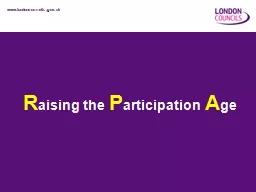PPT-R aising the
Author : briana-ranney | Published Date : 2015-09-26
P articipation A ge 1 What is it Raising the Participation Age RPA means that young people will be required to participate in education or training to the end
Presentation Embed Code
Download Presentation
Download Presentation The PPT/PDF document "R aising the" is the property of its rightful owner. Permission is granted to download and print the materials on this website for personal, non-commercial use only, and to display it on your personal computer provided you do not modify the materials and that you retain all copyright notices contained in the materials. By downloading content from our website, you accept the terms of this agreement.
R aising the: Transcript
Download Rules Of Document
"R aising the"The content belongs to its owner. You may download and print it for personal use, without modification, and keep all copyright notices. By downloading, you agree to these terms.
Related Documents




